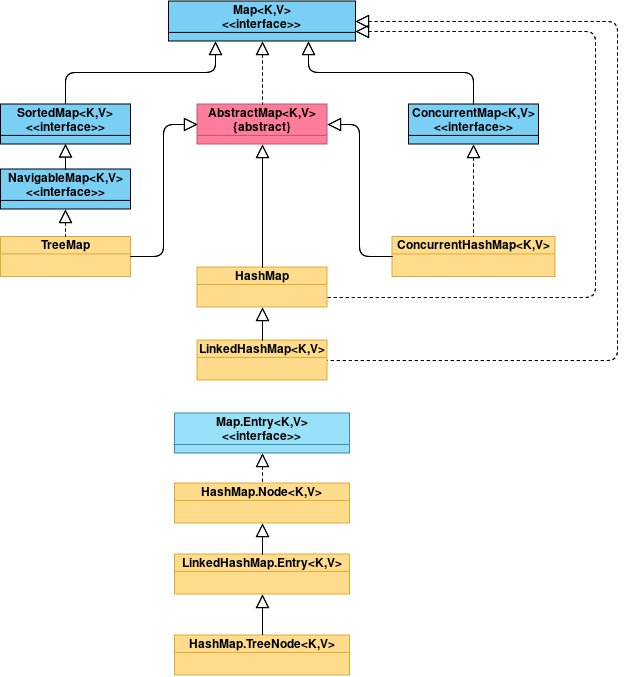Map 类继承结构图

Map<K,V> 接口常用方法
// since JDK1.2
public interface Map<K,V> {
boolean containsKey(Object key)
boolean containsValue(Object value) // 相比查找 key,查找 value 通常是 O(n)
V remove(Object key) // 存在,返回被删除的Value,不存在,返回 null
V put(K key, V value) // key存在,放回旧的内容,不存在,返回null
V get(Object key) // 返回 null,如果key不存在
default V putIfAbsent(K key, V value) // 存在,不更新,返回当前Value/不存在,更新,返回null
default V getOrDefault(Object key, V defaultValue) // 不存在,返回 defaultVal
Set<K> keySet()
Collection<V> values()
Set<Map.Entry<K,V>> entrySet()
}
// 内部接口
public static interface Map.Entry<K,V> {
K getKey()
V getValue()
}
1
2
3
4
5
6
7
8
9
10
11
12
13
14
15
16
17
18
19
20
21
2
3
4
5
6
7
8
9
10
11
12
13
14
15
16
17
18
19
20
21
SortedMap<K,V> 拓展 Map 的方法
K firstKey() // 返回 first (lowest) key
K lastKey() // 返回 last (highest) key
SortedMap<K,V> headMap(K toKey) // 返回 [...,tokey) 部分,<
SortedMap<K,V> tailMap(K fromKey) // 返回 [fromKey, ..] 部分,>=
SortedMap<K,V> subMap(K fromKey, K toKey) // 返回 [fromKey, toKey)部分
1
2
3
4
5
2
3
4
5
NavigableMap<K,V> 拓展 SortedMap 的方法
// key 相关,且方法中的 xxxKey 可以换成 xxxEntry,返回值变为 Map.Entry<K,V>
K lowerKey(K key) // 小于给定key的最大key
K floorKey(K key) // 小于等于给定key的最大key
K higherKey(K key) // 大于给定key的最小key
K ceilingKey(K key) // 大于等于给定key的最小key
// Entry 相关
Map.Entry<K,V> firstEntry() // 最小的节点,或 null 代表空,O(logn) 树的高度
Map.Entry<K,V> lastEntry()
Map.Entry<K,V> pollFirstEntry() // 弹出最小的节点
Map.Entry<K,V> pollLastEntry()
// 整体相关
NavigableMap<K,V> descendingMap() // 返回 reverse 排序规则后的Map,允许修改或插入
NavigableSet<K> navigableKeySet() // 返回key的Set,不允许add操作,允许remove操作
NavigableSet<K> descendingKeySet() // 返回 reverse 排序规则后key的Set
1
2
3
4
5
6
7
8
9
10
11
12
13
14
15
16
17
18
19
2
3
4
5
6
7
8
9
10
11
12
13
14
15
16
17
18
19